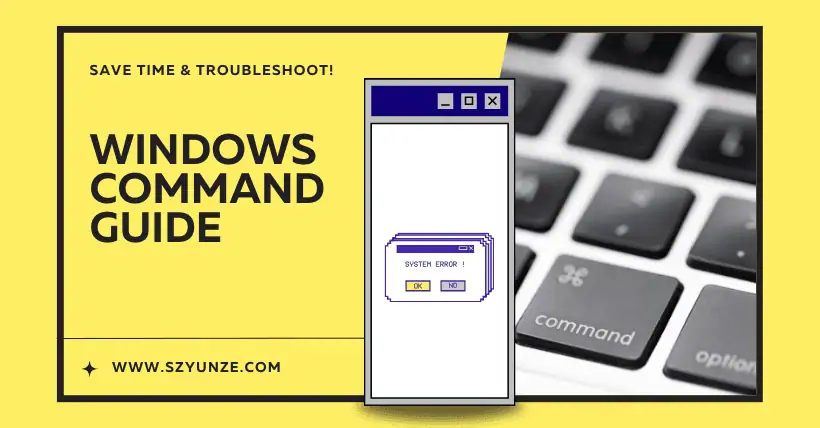Here are some commonly used Windows commands I’ve prepared for you. If you like them, give me a like, comment, and share!
01
ipconfig – Check Network Status
If your computer can’t connect to the internet, don’t panic. Open Command Prompt, type ipconfig, and press Enter. Look for the “Default Gateway” (usually something like 192.168.1.1), copy it into your browser, and you’ll access your router’s settings.
Forgot your WiFi password? Use ipconfig /all, find “Wireless LAN adapter,” look for “Security Key,” and check “Show characters” to reveal the password.
02
ping – Test Internet Speed
Is your game lagging? Type ping www.google.com -t and press Enter. The time=XXms shows the network latency—if it’s over 100ms, check your connection. If you see “Request timed out,” your router might be the issue. Press Ctrl + C to stop the test. This trick also works for checking if your company has blocked Taobao.
03
taskkill – Kill Processes
If your computer freezes, don’t unplug it. Use tasklist to see running processes, find the one using over 50% CPU, note its PID, then use taskkill /pid [PID] /f to force close it. Be careful not to kill system processes (Windows-related ones), or you might get a blue screen.
04
shutdown – Schedule Shutdown
Need to leave while downloading a large file? Use shutdown -s -t 3600 to schedule shutdown in 1 hour (time in seconds). To cancel, type shutdown -a. This command has saved many people from losing unsaved PowerPoint files. You can also prank a coworker by setting shutdown -s -t 300 to shut down their PC in 5 minutes.
05
attrib – Reveal Hidden Files
If your USB drive isn’t showing files, type attrib -s -h /s /d *.* to uncover all hidden files. To search for missing photos on the D drive, first switch to it using D:, then run the command. Be aware that antivirus software might flag this action.
06
sfc – Repair System Files
Frequent blue screens? Before reinstalling Windows, try sfc /scannow. Run it as an administrator and wait for about 30 minutes—it will automatically fix corrupted system files. This command once saved my PC when it got stuck on the boot logo.
07
chkdsk – Check Hard Drive
If your HDD is making weird noises, run chkdsk C: /f (replace C: with your drive letter). This scans and repairs disk errors. Warning: It locks the drive during the scan, so run it before leaving work.
08
diskpart – Manage Partitions
Got a new hard drive? Open diskpart, type list disk to see available drives, then select disk 1 (make sure you choose the right one), clean to erase everything, and create partition primary to create a new partition. Warning: Selecting the wrong disk will wipe all data!
09
netstat – Check Open Ports
Worried about malware? Run netstat -ano to list active connections. If you see a suspicious IP under “Foreign Address,” use tasklist to find the process linked to that PID—this can help you catch hidden malware.
10
systeminfo – Check System Details
Buying a second-hand PC? Use systeminfo to reveal CPU model, RAM size, and Windows installation date. Pay attention to the “Original Install Date”—if it doesn’t match the seller’s claim, it might be a refurbished machine.
11
dxdiag – Check Graphics Card
Games crashing? Type dxdiag to open the DirectX Diagnostic Tool. Under the “Display” tab, check your GPU model and driver date—if the driver is over two years old, update it. This tool also shows sound card details and connected devices.
12
mstsc – Remote Desktop Connection
Working from home? Type mstsc to open Remote Desktop Connection, enter the target computer’s IP, and control it remotely. The other PC must have remote access enabled. IT teams often use this to help colleagues fix issues.
13
powercfg – Battery Health Report
Laptop battery draining fast? Run powercfg /batteryreport to generate a detailed report. Compare “DESIGN CAPACITY” vs. “FULL CHARGE CAPACITY”—if it’s below 80%, your battery needs replacing.
14
robocopy – Fast File Transfer
Copying large files is slow? Use robocopy [source] [destination] /MIR for fast mirroring, with automatic resume if interrupted. It’s three times faster than drag-and-drop and skips duplicate files.
15
netsh – Reset Network
WiFi icon missing? Use netsh winsock reset, restart your PC, and it will fix 90% of network issues. Combine it with ipconfig /flushdns to clear the DNS cache and speed up browsing.
16
Final Tips
- Be extra cautious with commands like
format,clean, anddel. - Always back up important data before modifying system settings.
- Avoid deleting folders with
$symbols—they are crucial system files. - Research unknown processes before terminating them.
- On a work computer, be careful with
diskpart—messing up a server could cost you months of salary!
These commands are like a Swiss Army knife—unnoticed most of the time, but life-saving when needed. Don’t worry if you can’t memorize them all; write down the essentials on a sticky note and keep it on your monitor. One day, when a coworker’s PC crashes and you fix it with just a few commands, they’ll see you as a hacker genius. 🚀

Disclaimer:
- This channel does not make any representations or warranties regarding the availability, accuracy, timeliness, effectiveness, or completeness of any information posted. It hereby disclaims any liability or consequences arising from the use of the information.
- This channel is non-commercial and non-profit. The re-posted content does not signify endorsement of its views or responsibility for its authenticity. It does not intend to constitute any other guidance. This channel is not liable for any inaccuracies or errors in the re-posted or published information, directly or indirectly.
- Some data, materials, text, images, etc., used in this channel are sourced from the internet, and all reposts are duly credited to their sources. If you discover any work that infringes on your intellectual property rights or personal legal interests, please contact us, and we will promptly modify or remove it.



